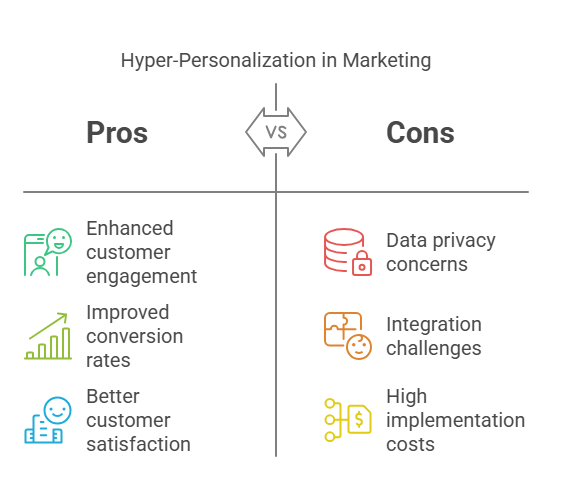Introduction
In the present-day digital marketing environment, consumers are overwhelmed with one-size-fits-all marketing communication that fails to resonate. Consumer expectations are changing, and organizations need to pivot from traditional marketing practices to more personalized means of marketing. This is where hyper-personalization comes in, and it is fueled by artificial intelligence (AI) to create individual experiences at scale.
Understanding Hyper-Personalization
What is Hyper-Personalization?
Hyper-personalization takes personalization a step further by utilizing the power of AI and real-time information to provide even more relevant content, product recommendations, and experiences to individual users. While personalization segmented audiences into generalized demographics, hyper-personalization treats every customer as a unique entity.
The Role of AI in Hyper-Personalization
Marketers can use AI powered personalization to analyze data across various customer activities including browsing behavior, purchase history, and social media activity to predict customer needs and preferences. This predictive capability enables marketers to deliver relevant content at the right point in time providing a better customer experience.
Benefits of AI-Driven Hyper-Personalization
- Greater Customer Engagement: When companies deliver content with personalization that reflects their users’ characteristics, they are able to develop far more engagement in-to the content that they have delivered. When companies have personalized experiences, users feel valued. This, in turn, builds loyalty with those consumers, and they are far more likely to repeat their business.
- Improved Conversion Rates: AI driven marketing automation tools can allow companies to optimize the times and channels at which they reach those consumers increasing the likelihood of winning conversions. Tailored recommendations of products and personalized offers will also increase purchase rates.
- Efficient Resource Allocation: By being able to automate many of its personalization efforts through AI, marketing teams are able to save time in a relatively manual task so that they can devote those time savings to strategy and the creative side of their engagement strategies. Therefore, utilizing AI personalization will also save companies money and improve return on investments (ROIs).

Implementing Hyper-Personalization Strategies
- Data Collection & Integration: Comprehensive data collection is the foundation of hyper-personalization. It is crucial to integrate data from different areas — such as Customer Relationship Management (CRM) systems, web traffic, social media platforms, etc. — to deliver a complete customer profile.
- Utilizing AI Tools: Leverage AI marketing automation tools to analyze existing customer data and automate the delivery of personalized content. Supportive tools like dynamic content generators and predictive analytics platforms will simplify this undertaking.
- Continuous Optimization: Continuously monitor and analyze the performance of the strategies deployed for personalized campaigns. Utilize the insight gained from the current campaign to influence and optimize overall strategy, and subsequently interactions with current and future customers.

Real-World Applications
- E-Commerce Personalization: E-commerce retailers have begun to personalize shoppers’ experiences with the assistance of AI. For instance, retailers now use AI to curate product recommendations based on a shopper’s past purchases and browsing history. AI has enabled retailers to personalize their shopper’s experience and thereby increase e-commerce revenues.
- Email Marketing: Using AI to personalize email marketing can allow a marketer to be more effective by personalizing email subject lines, content, and times of delivery to align with an individual customer’s behaviors and proclivities. This can yield improved open rates and improved click-through rates.
- Website Experience: Websites now provide dynamic content that changes according to the user’s previous behavior and stated preferences. Personalization can improve users’ engagement and lower bounce rates.
Challenges and Considerations
- Data Privacy Issues: The more data collected means more responsibility to protect customer information. Be sure to comply with data protection laws and keep customers informed on how their data is used.
- Integration Difficulties: Using AI-powered personalization takes data from multiple different sources and integrates those sources and systems together. A solid strategy and the right technology partners for integration are vital for function and integration.

Future Trends in Hyper-Personalization
As AI technology continues to advance, expect to see more sophisticated personalization techniques, such as:
- Real-time personalization across multiple channels
- Predictive customer journey mapping
- Voice and conversational AI enhancing customer interactions
Conclusion:
Hyper-personalization powered by AI is no longer a luxury—it’s a necessity in today’s competitive market. By delivering tailored experiences, businesses can enhance customer satisfaction, drive conversions, and build lasting relationships.
💡 Smarter Marketing Starts Here.
Personalize every touchpoint with AI-driven insights.
🚀 Get Your Free AI Marketing Strategy Today!
FAQs
Q: What is hyper-personalization in marketing?
Hyper-personalization uses real-time data, AI, and machine learning to deliver highly relevant and tailored content, offers, and experiences to individual users—far beyond basic segmentation or name-based personalization.
Q: How is AI used in hyper-personalized marketing?
AI analyzes customer behavior, preferences, past interactions, and real-time signals to deliver dynamic, personalized experiences across channels like email, websites, chatbots, and ads.
Q: What’s the difference between personalization and hyper-personalization?
- Personalization: Generic segmentation like first names or product categories.
- Hyper-personalization: Uses real-time behavioral data, predictive analytics, and AI algorithms to adapt each touchpoint to the individual’s intent, timing, and preferences.
Q: Why is hyper-personalization important for customer journeys?
Because modern consumers expect instant, relevant experiences. Hyper-personalization boosts engagement, conversion rates, customer loyalty, and helps reduce churn by anticipating customer needs.
Q: Do I need a large marketing team to implement hyper-personalization?
Not at all. With AI-powered tools and platforms, even small teams can scale personalized marketing using automation and no-code solutions.